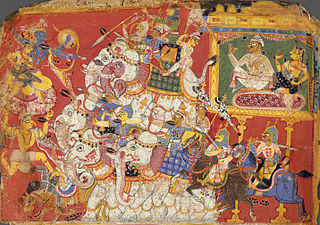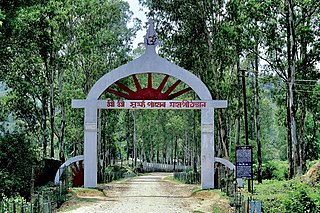
Tezpur is a city and urban agglomeration in Sonitpur district, Assam state, India. Tezpur is located on the banks of the river Brahmaputra, 175 kilometres (109 mi) northeast of Guwahati, and is the largest of the north bank cities with a population exceeding 100,000 as per Metropolitan Census 2011.

The Kamakhya Temple is a Sakta temple dedicated to the mother goddess Kamakhya. It is one of the oldest of the 51 Shakti Pithas. Situated on the Nilachal Hill in western part of Guwahati city in Assam, India, it is the main temple in a complex of individual temples dedicated to the ten Mahavidyas of Saktism, namely, Kali, Tara, Tripura Sundari, Bhuvaneshwari, Bhairavi, Chhinnamasta, Dhumavati, Bagalamukhi, Matangi and Kamalatmika. Among these, Tripurasundari, Matangi and Kamala reside inside the main temple whereas the other seven reside in individual temples. It is an important pilgrimage destination for Hindus and especially for Tantric worshipers.

Kamarupa, an early state during the Classical period on the Indian subcontinent, was the first historical kingdom of Assam.

Naraka, also known as Narakasura, was a mythical asura king, the legendary progenitor of all three dynasties of Pragjyotisha-Kamarupa, and the founding ruler of the legendary Bhauma dynasty of Pragjyotisha. Though the myths about Naraka are first mentioned in the Mahabharata, later texts embellish them. According to later post-Vedic texts such as the Brahma Purana and Vishnu Purana, he was the son of Bhudevi, fathered either by the Varaha incarnation of Vishnu or Hiranyaksha. He is claimed as one who established Pragjyotisha. He was killed by Krishna and Satyabhama. His son Bhagadatta—of Mahabharata fame—succeeded him.

The Varman dynasty (350-650) was the first historical dynasty of the Kamarupa kingdom. It was established by Pushyavarman, a contemporary of Samudragupta. The earlier Varmans were subordinates of the Gupta Empire, but as the power of the Guptas waned, Mahendravarman (470-494) performed two horse sacrifices and the status of Kamarupa as independent state remained umimpaired. According to the Allahabad Prasasti, the ruler of Kamarupa was a frontier ruler (Pratyanta-nrpatis) of the great Gupta emperor.

The Mlechchha dynasty ruled Kamarupa from their capital at Harruppesvar in present-day Tezpur, Assam, after the fall of the Varman dynasty. According to historical records, there were twenty one rulers in this dynasty, but the line is obscure and names of some intervening rulers are not known.

North Guwahati is northern part of the city of Guwahati and a town area committee in Kamrup Rural district in the Indian state of Assam.This town abounds in historical places and picnic spots. National Highway 27 passes through North Guwahati. Amingaon neighbourhood is district headquarter of Kamrup Rural district.
Fine Arts of Assam has extremely rich tradition.

Assam is the main and oldest state in the North-East Region of India and serves as the gateway to the rest of the Seven Sister States. The land of red river and blue hills, Assam comprises three main geographical areas: the Brahmaputra Valley which stretching along the length of the Brahmaputra river, the Barak Valley extending like a tail, and the intervening Karbi Plateau and North Cachar Hills. Assam shares its border with Meghalaya, Arunachal Pradesh, Nagaland, Manipur, Tripura, Mizoram and West Bengal; and there are National Highways leading to their capital cities. It also shares international borders with Bhutan and Bangladesh and is very close to Myanmar. In ancient times Assam was known as Pragjyotisha or Pragjyotishpura, and Kamarupa.

Lower Assam is a region situated in Western Brahmaputra Valley encompassing undivided Kamrup and Goalpara regions. Soon after the formal creation of the British districts in 1833, Lower Assam denoted one of the five initial districts that were created west of the Dhansiri river, which, along with the six paraganas, became a single district of Kamrup in 1836. It was home to the kingdom of Kamarupa, ruled by Varman's and Pala's from their capital's Pragjyotishpura (Guwahati) and Durjaya. Today Guwahati is the largest city of North-East India while Dispur, the capital of Assam, is within the town.

Sri Surya Pahar is located about 12 km southeast of Goalpara, about 132 km northwest of Guwahati, is a significant but relatively unknown archaeological site in Assam, India. Goalpara is the nearest city from the site. The site is a hilly terrain where several rock-cut Shivalingas, votive stupas and the deities of Hindu, Buddhist and Jain pantheon are scattered in an area of about one km. The site is centered on the hills (Pahar) of Sri Surya which is profusely filled up with Shiva Lingas (Lingam). The popular belief is that 99999 Shiva Lingas were engraved here by Vyasa in order to build up a second Kashi and once it was one of the holiest pilgrimage sites in the region. There is no historical evidence exactly how many Lingams once dotted in these hills, but still there are hundreds of them, from tiny to large in size, scattered everywhere at the foot of the hill and covering the extensive area after centuries of neglect and pilferage. The exact figure of the Lingas in the hill is yet to be counted scientifically.

Kalyanavarman ruled Kamarupa from the Varman dynasty for the period of 422-446 A.D. He was the son of Kamrupi king Balavarman and queen Ratnavati. He married Gandharvavati and had a successor to throne named Ganapativarman.

Narayanavarman ruled Kamarupa from the Varman dynasty for the period 494-518, was son of Kamarupi King Mahendravarman and Queen Suvrata. He married Devavati and had successor to throne named Bhutivarman.

Susthitavarman (590-595) was a ruler of Kamarupa. He was a son of Sthitavarman and Queen Nayanadevi.

Go Pala was successor and son of Indra Pala and his queen Rajya Devi, of Pala Dynasty of Kamarupa Kingdom, who ruled for the period 990-1015 A.D.

Harsha Pala was son of Go Pala, the ruler of Pala Dynasty of Kamarupa Kingdom and Queen Nayana. He ruled for the period 1015-1035 A.D.
Kamrupi literature is the literature written in the modern Kamrupi dialects of Assamese language.

Silsako was an ancient stone bridge over a channel of river Barnadi in Hajo, Kamrup. As the channel changed its course over time, now the bridge is stranded in the middle of a small lake. It was an important transit route in ancient and medieval times. Many invaders like Muhammed Bin Bukhtiyar entered into Kamarupa in the year 1205-06 AD, and crossed the bridge Silsako. This historical bridge sustained damage in the 1897 Assam earthquake.

Hayagriva Madhava Temple is situated on the Monikut hill. The hill is situated in Hajo of Kamrup District in Assam, India. Which is around 30 km to west of Guwahati. The Kalika Purana composed in the 11th century CE in Kamarupa talks about the origin of this form of Vishnu and his final establishment in the hill of Monikut, where the present temple is located. The present temple structure was constructed by the King Raghudeva Narayan in 1583. According to some historians the King of Pala dynasty constructed it in 10th century. It is a stone temple and it enshrines an image of Hayagriva Madhava. Some Buddhists believe that the Hayagriva Madhava temple, best known in the group of Hindu temples, is where the Buddha attained Nirvana. At this imposing temple, the presiding deity is Vishnu, worshipped in the sanctum sanctorum as an idol carved of black stone. Four other stone idols are also in worship as subsidiary deities.

Kamapitha is one of the four Kamarupa Pithas, the geographical divisions of ancient Kamarupa. Dineshchandra Sircar points out that these divisions are not found in the Kamarupa inscriptions and that they might be fabrications from late medieval sources, such as 16th-century work Yogini Tantra gives the boundaries of Kamapitha and other three pithas, the same work which gives boundaries of ancient Kamrup kingdom as well. The eastern border of Kamarupa was the temple of the goddess Tamreshvari near present-day Sadiya



















